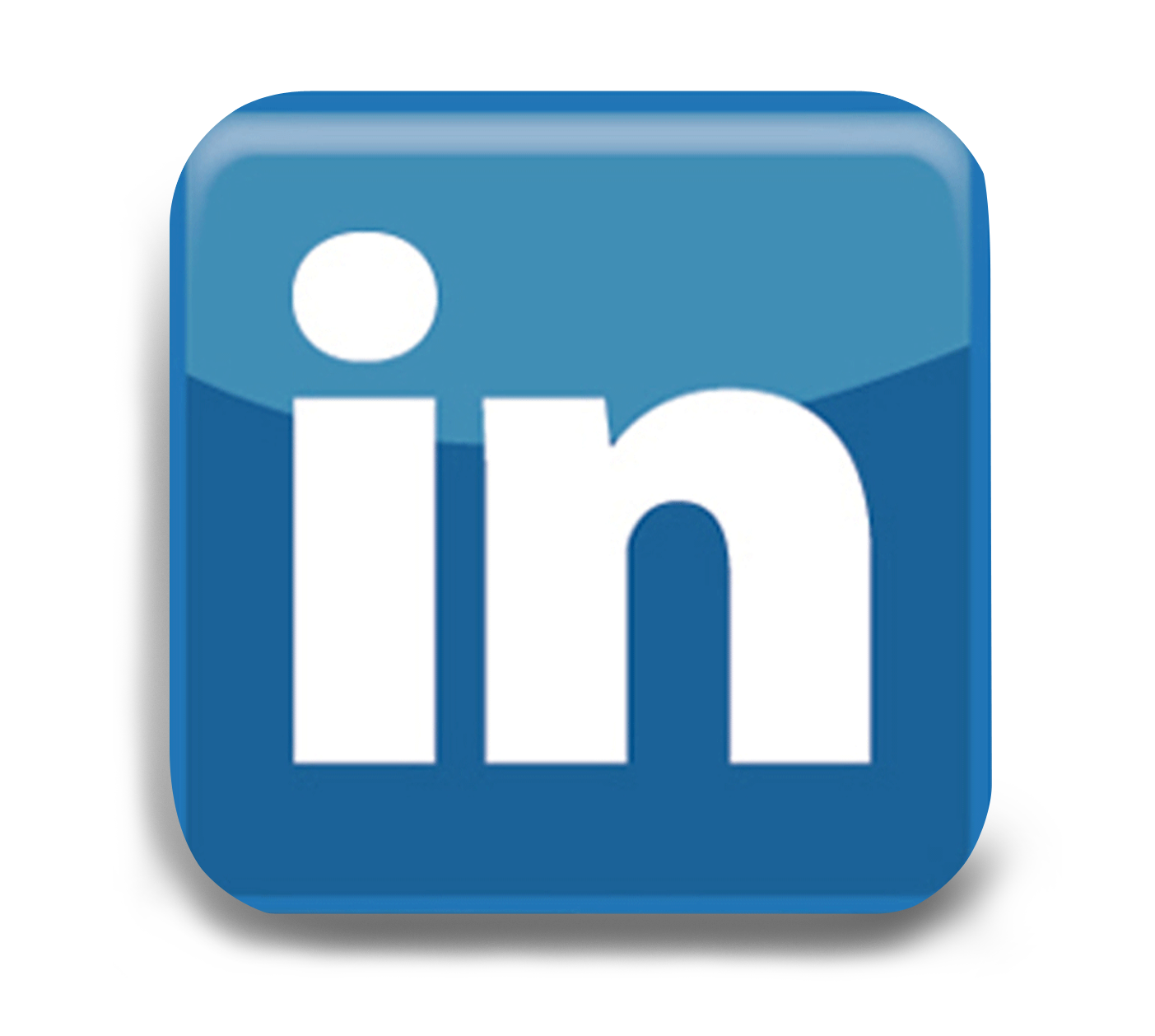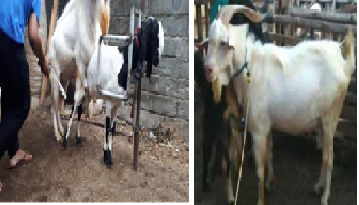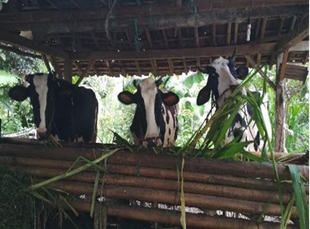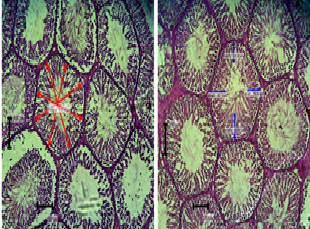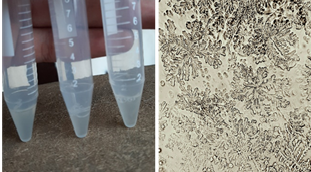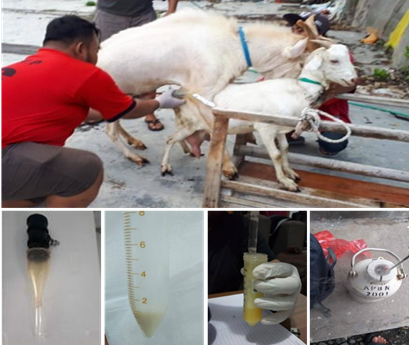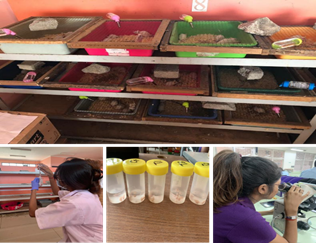Cranium morphometry for distinguishing male and female Muscovy duck (Cairina moschata) before sexual maturity

Downloads
Gender determination of Muscovy duck as early as possible is essential for the efficiency and effectiveness of duck production. This study aimed to determine the morphometric differences in prepubertal male and female Muscovy duck (Cairina moschata) as predictors of gender. This study used a split-plot design, with the observed variables cranium length, width and height, mandibular length, and rostrum length and width. This study used a total of 80 samples of duck heads consisting of 40 male and 40 female Muscovy duck heads, with ten heads each in the age group of 2, 4, 6, and 8 weeks, respectively. Results showed that the length, width, and height of the cranium, mandibular length, and rostrum lengthand width were greater in males (p <0.05) than those of the females in all age groups. It could be concluded that the morphometric size of prepubertal male Muscovy ducks head was greater than those of the female ones at the same age; thereby, it could be used to distinguish gender. Based on the morphometrics, further study can also be conducted to measure other body parts of the Muscovy duck apart from the cranium. In addition, it is necessary to study the morphometric measurements of the cranium in other poultry as a basis for identifying sex.
Ackert-Bicknell CL, Karasik D. 2013. Impact of the environment on the skeleton: is it modulated by genetic factors? Curr Osteoporos Rep. 11: 219-28.
Almeida M, Laurent MR, Dubois V, Claessens F, O'Brien CA, Bouillon R, Vanderschueren D, Manolagas SC. 2017. Estrogens and Androgens in Skeletal Physiology and Pathophysiology. Physiol Rev. 97: 135-87.
Bushby EV, Friel M, Goold C, Gray H, Smith L, Collins LM. 2018. Factors Influencing Individual Variation in Farm Animal Cognition and How to Account for These Statistically. Front Vet Sci. 5:193.
Calabuig CP, Green AJ, Ferrer M, Muriel R, Moreira H. 2011. Sexual size dimorphism and sex determination by morphometric measurements in the Coscoroba Swan. Stud Neotrop Fauna Environ. 46: 177-84.
Campomanes-Álvarez C, Martos-Fernández R, Wilkinson C, Ibanez O, Cordon O. 2018. Modeling Skull-face Anatomical/ Morphological Correspondence for Craniofacial Superimposition-Based Identification. IEEE Trans Inf Forensics Secur. 13: 1-14.
Chen JF, Lin PW, Tsai YR, Yang YC, Kang HY. 2019. Androgens and Androgen Receptor Actions on Bone Health and Disease: From Androgen Deficiency to Androgen Therapy. Cells. 8: 1318.
Dayan MO, Demiraslan Y, Akbulut Y, Duymus M, dan Sirri Akosman M. 2014. The Morphometric Values of the Native Duck and Gooses' Heads: A Computed Tomography Study. Anim Vet Sci. 2: 175-8.
Devesa J, Almengló C, Devesa P. 2016. Multiple Effects of Growth Hormone in the Body: Is it Really the Hormone for Growth? Clin Med Insights Endocrinol Diabetes 9: 47-71.
El-Gendy EM, Asmaa MI, El-Bably SH, Shaker NA, Shaimaa HH. 2016. Morphological and Histological Studies on the Female Oviduct of Balady Duck (Anas boschas domesticus). Int. J. Adv. Res. Biol. Sci. 3: 171-80.
Florencio-Silva R, Sasso GR, Sasso-Cerri E, Simíµes MJ, Cerri PS. 2015. Biology of Bone Tissue: Structure, Function, and Factors That Influence Bone Cells. Biomed Res Int. 2015: 421746.
Fouad AM, Ruan D, Wang S, Chen W, Xia W, Zheng C. 2018. Nutritional requirements of meat-type and egg-type ducks: what do we know? J Anim Sci Biotechnol. 9:1.
Gerzilov V, Bochukov A, Penchev G, Petrov P. 2016. Testicular development in the muscovy duck (Cairina moschata). Bulg J Vet Med. 19: 8-18.
Gibney J, Wolthers T, Johannsson G, Umpleby AM, Ho KK. 2005. Growth hormone and testosterone interact positively to enhance protein and energy metabolism in hypopituitary men. Am J Physiol Endocrinol Metab. 289: E266-71.
Hartnett KM, Fulginiti LC, Di Modica F. 2011. The effects of corrosive substances on human bone, teeth, hair, nails, and soft tissue. J Forensic Sci. 56: 954-9.
Ismoyowati I, Indrasanti D, Mugiyono S, Pangestu M. 2019. Phytogenic compounds do not interfere physiological parameters and growth performances on two Indonesian local breeds of ducks. Vet World 12: 1689-97.
KokoszyÅ„ski D, Wasilewski R, Saleh M, PiwczyÅ„ski D, ArpáÅ¡ová H, HrnÄar C, Fik M. 2019. Growth Performance, Body Measurements, Carcass and Some Internal Organs Characteristics of Pekin Ducks. Animals (Basel) 9: 963.
Leisler B, Winkler H. 2020. The role of female investment in a sexual arms race. Journal of Avian Biology. 51: 1-9.
Oguntunji AO, Ayorinde KL. 2014. Multivariate analysis of morphological traits of the nigerian muscovy ducks (Cairina moschata). Arch. Zootec. 63: 483-93.
Parra-Torres AY, Valdés-Flores M, Orozco L, Velázquez-Cruz R. 2013. Molecular Aspects of Bone Remodeling. In: Valdes-Flores M. (Ed.), Topics in Osteoporosis. IntechOpen.
Soliman A, De Sanctis V, Elalaily R, Bedair S. 2014. Advances in pubertal growth and factors influencing it: Can we increase pubertal growth? Indian J Endocrinol Metab. 18: S53-62.
Tanganyika J, Webb EC. 2019. Influence of production systems and sex on nutritional value and meat quality of native Malawian Muscovy ducks. S Afr J Anim Sci. 49: 1113-26.
Tritos NA, Klibanski A. 2016. Effects of Growth Hormone on Bone. Prog Mol Biol Transl Sci. 138: 193-211.
Copyright (c) 2022 Mafatichul Firdaus, Abdul Samik, Yeni Dhamayanti, Raden Tatang Santanu Adikara, Hana Eliyani, Soeharsono Soeharsono

This work is licensed under a Creative Commons Attribution-ShareAlike 4.0 International License.
Ovozoa by Unair is licensed under a Creative Commons Attribution-ShareAlike 4.0 International License.
1. The journal allows the author to hold the copyright of the article without restrictions.
2. The journal allows the author(s) to retain publishing rights without restrictions
3. The legal formal aspect of journal publication accessibility refers to Creative Commons Attribution Share-Alike (CC BY-SA).
4. The Creative Commons Attribution Share-Alike (CC BY-SA) license allows re-distribution and re-use of a licensed work on the conditions that the creator is appropriately credited and that any derivative work is made available under "the same, similar or a compatible license”. Other than the conditions mentioned above, the editorial board is not responsible for copyright violation.










